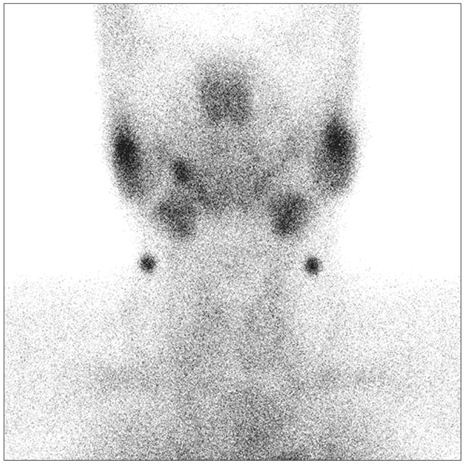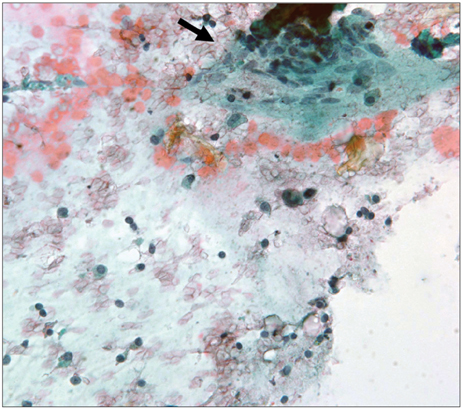J Clin Neurol.
2008 Dec;4(4):167-170. 10.3988/jcn.2008.4.4.167.
Steroid-Responsive Recurrent Encephalopathy Associated with Subacute Thyroiditis
- Affiliations
-
- 1Division of Endocrinology, Department of Internal Medicine, Chung-Ang University College of Medicine, Seoul, Korea.
- 2Department of Neurology, Chung-Ang University College of Medicine, Seoul, Korea. kwangyeol.park@gmail.com
- KMID: 2287671
- DOI: http://doi.org/10.3988/jcn.2008.4.4.167
Abstract
- BACKGROUND
Steroid-responsive encephalopathy associated with subacute thyroiditis has, to our knowledge, not been reported previously. CASE REPORT: A 49-year-old woman was found collapsed and brought to our institution with decreased mentality, dysarthria, and gait disturbance. Brain magnetic resonance imaging and angiography were normal but blood tests revealed thyroid-autoantibody-negative thyrotoxicosis. Results of a (99m)technetium-pertechnetate scan were compatible with the thyrotoxic phase of subacute thyroiditis. 14-3-3 proteins were detected in cerebrospinal fluid. Her mental status began to improve from the day following steroid administration. Recurrent encephalopathy was found 2 months after the initial admission, which was also effectively treated with steroid. CONCLUSIONS:We speculate that steroid-responsive recurrent encephalopathy associated with subacute thyroiditis is a subtype of Hashimoto's encephalopathy, and consider that steroid treatment should not be delayed in suspected patients.
MeSH Terms
Figure
Reference
-
1. Brain L, Jellinek EH, Ball K. Hashimoto's disease and encephalopathy. Lancet. 1966. 2:512–514.
Article2. Castillo P, Woodruff B, Caselli R, Vernino S, Lucchinetti C, Swanson J, et al. Steroid-responsive encephalopathy associated with autoimmune thyroiditis. Arch Neurol. 2006. 63:197–202.
Article3. Kang SY, Choi JC, Kang JH. Two cases of hypertensive encephalopathy involving the brainstem. J Clin Neurol. 2007. 3:50–52.
Article4. McHugh JC, Ryan AM, Lynch T, Dempsey E, Stack J, Farrell MA, et al. Steroid-responsive recurrent encephalopathy in a patient with cerebral amyloid angiopathy. Cerebrovasc Dis. 2007. 23:66–69.
Article5. Chong JY, Rowland LP, Utiger RD. Hashimoto encephalopathy: syndrome or myth? Arch Neurol. 2003. 60:164–171.6. Vernino S, Geschwind M, Boeve B. Autoimmune encephalopathies. Neurologist. 2007. 13:140–147.
Article7. Creutzfeldt CJ, Haberl RL. Hashimoto encephalopathy: a do-not-miss in the differential diagnosis of dementia. J Neurol. 2005. 252:1285–1287.
Article8. Doherty CP, Schlossmacher M, Torres N, Bromfield E, Samuels MA, Folkerth R. Hashimoto's encephalopathy mimicking Creutzfeldt-Jakob disease: brain biopsy findings. J Neurol Neurosurg Psychiatry. 2002. 73:601–602.
Article9. Yuceyar N, Karadeniz M, Erdogan M, Copur A, Akgun A, Kumral E, et al. Thyrotoxic autoimmune encephalopathy in a female patient: only partial response to typical immunosuppressant treatment and remission after thyroidectomy. Clin Neurol Neurosurg. 2007. 109:458–462.
Article10. Yoneda M, Fujii A, Ito A, Yokoyama H, Nakagawa H, Kuriyama M. High prevalence of serum autoantibodies against the amino terminal of alpha-enolase in Hashimoto's encephalopathy. J Neuroimmunol. 2007. 185:195–200.
Article11. Oide T, Tokuda T, Yazaki M, Watarai M, Mitsuhashi S, Kaneko K, et al. Anti-neuronal autoantibody in Hashimoto's encephalopathy: neuropathological, immunohistochemical, and biochemical analysis of two patients. J Neurol Sci. 2004. 217:7–12.
Article12. Seo SW, Lee BI, Lee JD, Park SA, Kim KS, Kim SH, et al. Thyrotoxic autoimmune encephalopathy: a repeat positron emission tomography study. J Neurol Neurosurg Psychiatry. 2003. 74:504–506.
Article13. Katoh N, Yoshida T, Shimojima Y, Gono T, Matsuda M, Yoneda M, et al. An 85-year-old case with Hashimoto's encephalopathy, showing spontaneous complete remission. Intern Med. 2007. 46:1613–1616.
Article14. Chong JY, Rowland LP. What's in a NAIM? Hashimoto encephalopathy, steroid-responsive encephalopathy associated with autoimmune thyroiditis, or nonvasculitic autoimmune meningoencephalitis? Arch Neurol. 2006. 63:175–176.15. Utsumiya K, Arakawa R, Fujimoto S, Ueyama H, Kumamoto T. [A case of steroid-responsive encephalopathy with positive 14-3-3 protein of the cerebrospinal fluid clinically resembling Creutzfelt-Jakob disease]. Rinsho Shinkeigaku. 2004. 44:618–622.16. Fu H, Subramanian RR, Masters SC. 14-3-3 proteins: structure, function, and regulation. Annu Rev Pharmacol Toxicol. 2000. 40:617–647.
Article17. Fujii K, Tanabe Y, Uchikawa H, Kobayashi K, Kubota H, Takanashi J, et al. 14-3-3 protein detection in the cerebrospinal fluid of patients with influenza-associated encephalopathy. J Child Neurol. 2006. 21:562–565.
Article
- Full Text Links
- Actions
-
Cited
- CITED
-
- Close
- Share
- Similar articles
-
- Graves' Disease Following Recurrent Subacute Thyroiditis
- A Case of Graves' Disease Following Subacute Thyroiditis
- A Case of Riedel's Thyroiditis in a Patient with a History of Subacute Thyroiditis
- Nonconvulsive Status Epilepticus as the First Manifestation of Hashimoto's Encephalopathy
- A case of an autonomously functioning thyroid nodule combined with subacute thyroiditis



